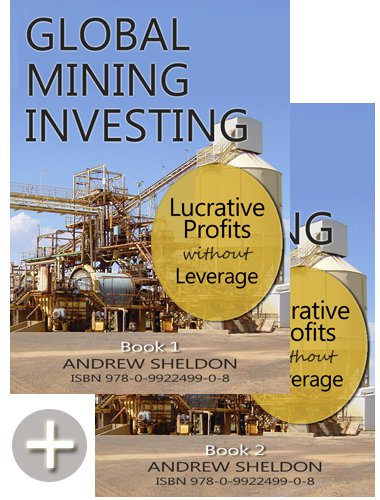
 Global Mining Investing $69.95, 2 Volume e-Book Set. Buy here.
Global Mining Investing $69.95, 2 Volume e-Book Set. Buy here.Author, Andrew Sheldon
Global Mining Investing is a reference eBook to teach investors how to think and act as investors with a underlying theme of managing risk. The book touches on a huge amount of content which heavily relies on knowledge that can only be obtained through experience...The text was engaging, as I knew the valuable outcome was to be a better thinker and investor.
While some books (such as Coulson’s An Insider’s Guide to the Mining Sector) focus on one particular commodity this book (Global Mining Investing) attempts (and does well) to cover all types of mining and commodities.
Global Mining Investing - see store
Tuesday, September 25, 2007
Australian Agricultural Company (ASX.AAC)
I have previously made mention of the agricultural commodities - and the potential of companies like Qld Cotton, Namoi Cotton, Australian Wheat Board, Graincorp and Australian Agricultural Company. Since that time, we have seen the takeover of Qld Cotton by a Singapore-based company, and AWB hit by a number of law suits. The problem is that there isnt much exposure to the agricultural sector on the Australian ASX. The bulk of farms remain private family corporations. I suspect this is about to change for 2 reasons:

1. High levels of debt
2. Drought has undermined revenues
3. Hedging debacles
4. Rising costs for inputs, eg. Fuel, fertiliser, insecticide
5. Low prices for alot of commodities
6. A strong $Aust - now $0.87 to $US
Travelling through the Northern Territory, Qld and NSW, it was readily apparent to me that:
1. Farmers in the North are till benefiting from very good unseasonal rains in May'07 even though crop farmers are watching their crops fail. Pastures in the north are well grassed.
2. Some commodity prices are up, but some are down due to drought, mixed fortunes of those crops used by biofuel production.
3. Input prices like fuel and fertiliser have increased considerably in the last 6 months
So I think farm failures are going to result in a number of new ASX listings as agricultural commodities rise. Why do I think agricultural commodity based stocks are going to perform well:
1. More takeovers - from Japanese, Chinese, local and US companies particular
2. Higher commodity prices - stronger demand for beef from Asia in particular, strong demand for grains for energy and feed, the flow through of input prices
3. Final end to the drought
4. Consolidation of family farms offering expansion upside
5. Growing speculation on agricultural based commodities by financial institutions
Its not a sector that I know much about but I would also expect trading in water rights to be brisk and I suspect a lot of money will be made there. But as far as equities are concerned, I like Australian Agricultural Company (AAC) because:
1. It is a well managed company
2. It is a pure beef exposure - pasture and feedlots
3. The outlook for beef demand in Asia I think is particularly good
4. Geographic diversity - they own 1.2% of Australia (8mil hectares), with their stock dispersed among a multitude of properties - se www.aaco.com.au
5. Improving rainfall - despite the drought, the rainfall in the Carpentaria region (West Qld) is has been increasing over the last 50 years. The paddocks are currently well grassed.
6. The prospect of the drought ending - this is already the worst drought since the 1930s
Technically the AAC chart looks good as it consolidates at its moving average. Currently trading at $2.75, with an earnings yield of just 1.1% and a dividend yield of 5%. This implies to me that the stock is only just recovering from drought-affected earnings. The clear intent here is to position in a stock that will benefit from those unseasonal rains, higher future commodity prices and any cessation to the drought - when it finally comes. Given that we are breaking 100yr records, the end to the drought cant be too far off. In case you are thinking that the drought is really climate change - consider that over the last 50 years, the locations of AAC properties have actually benefited from a significant increase in rainfall - thats in the Carpentaria region.

Subscribe to:
Comments (Atom)
Japan Foreclosed Property 2015-2016 - Buy this 5th edition report!
You can view foreclosed properties listed for as little as $US10,000 in Japan thanks to depopulation and a culture that is geared towards working for the state. I bought foreclosed properties in Japan and now I reveal all in our expanded 350+page report. The information you need to know, strategies to apply, where to get help, and the tools to use. We even help you avoid the tsunami and nuclear risks since I was a geologist/mining finance analyst in a past life. Check out the "feedback" in our blog for stories of success by customers of our previous reports.
Download Table of Contents here.




